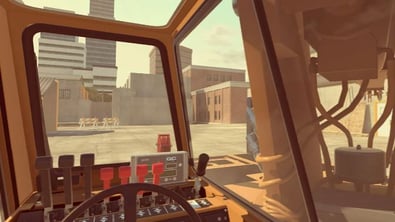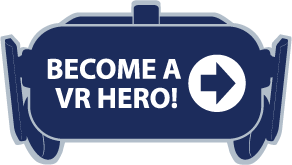In early 2018, ITI VR released the ITI Virtual Reality Carry Deck Simulator as part of the Q1 update. I had the opportunity to sit down with ITI Co-Founder and Technical Director, Mike Parnell, to discuss how carry deck cranes are used in heavy industry and his role in the design of unique training scenarios for the ITI VR Carry Deck simulator.
Amanda Henry: So, who commonly operates carry decks, and what environments and unique load handling assignments is this machine made for?
Mike Parnell: Quite often, carry decks are used by utility workers in mills, plants, and refineries. You might recognize that many of these utility workers are pipefitters, electricians, mechanics, or carpenters that need to move light items in tight areas and on to upper landings. Sometimes, the loads that are handled by carry decks are small pumps, motors, switch cabinets, and other light duty items that are awkward when traveling up and down stairs, but need to be moved inside or near very small, tight work areas for load handling, usually in 300 to 400 pound region. Carry decks are advantageous because they are able to pick up an item off a second or third floor window or landing in a mill, then can be brought down to its own deck or even using its pick-and-carry chart to back up and bring the object down to a rolling cart or some other transport system.
AH: What are the most common carry decks models available in the field such as make, models, capacities, engineering specs?
MP: The most common carry decks in the field seem to average between 4 ½ to 9-ton capacity. Shuttle Lift and Grove both make some variety of carry deck, the biggest manufacturer is Broderson out of the Kansas City area. They are the world leader in manufacturing of carry deck cranes, and have the broadest product line. Most all their makes and models have outrigger stabilizers, almost looking like small cranes – rough terrain cranes – at larger capacities. For the range of 4 ½ to 9-ton, they mostly have a 24 to 30-foot boom and have a swing around jib for that extra reach. They have on-outrigger capacity charts as well as on-rubber tire charts for being able to mobilize with a suspended load only from the boom tip not from the jib. They are also able to bring their load down onto the deck on the front or back side of the boom turret. This makes carry decks very useful and universal in how they are utilized throughout mills, plants, and refineries.
AH: What operational challenges are unique to carry decks, compared to other types of load handling equipment, that you take into consideration when designing training and assessment scenarios?

MP: Every crane family has a set of advantages and disadvantages, whether that’s a crawler crane with a lattice boom or a large hydraulic crane with outriggers and a fairly heavy telescopic boom. In the carry deck group, the first thing that we would look at, especially in designing a training program, is to focus on what the advantages are, particularly its easy access and maneuverability around tight areas. It calls for teaching an operator to get spotters to help ensure clearances while maneuvering the machine in small and tight areas. The operator must be able to set up the machine, get it level, get out of the machine and look at the job site, environment, lift, and set location to make sure everything is within capacity of the machine. Once the job is thoroughly evaluated, even from a training standpoint, we would want the operator to confirm that the load can be handled with sufficient head height.
Carry decks are unique in that they have a turret fairly close to the operator’s right shoulder and it creates something of a blind spot to look around or to ensure that he can observe all of the obstructions, equipment, or material that might be in the area. It is very important that they are constantly aware of their surroundings. As the seat is fixed facing forward, there may be a requirement that the operator needs to take the load and move it to the back or behind the machine, and certainly using a spotter, signal person, or some other assist is always helpful. Certainly, an advantage is to be able to put the load up onto the deck if it’s in the right size and weight range and can be secured if it needs to be transported. This is an advantage that most cranes don’t really offer – certainly a boom truck would or maybe an articulating crane, but these machines really are an answer to prayers for being able to get loads in and out and being their own transport system at the same time.
AH: Is there anything about virtual reality that makes training and assessing carry deck operations more advantageous?
MP: The number one advantage of being trained in virtual reality with carry decks is the ability to have so many different lift scenarios at your fingertips complete with rigging, load types, shapes, sizes, and weights. The training scenarios can be brought up one at a time, there is no additional personnel required to assist in the program, and the seat time gained by the candidate or the operator in training, because of simulation, will provide signal persons and tagline persons as necessary for some of the lifting activities. So, within an hour, it wouldn’t be hard for an operator to go through 15 different lifting activities all involving setting up the machine, leveling it, extending the boom, and much more. In that window of time, you can really accelerate your actual load manipulation time and hands on time to gain sensitivity of what the load is going to do, how the carry deck is going to react, and then, how to use the controls efficiently and effectively. Of course, all of this can be done at night, in the day time, in severe weather, good weather, 24/7, etc.; you are not hemmed in by weather conditions, locations or shift time because in simulation, all those challenges go away.
AH: What sort of scenarios did you design for the ITI VR Carry Deck Simulator and why?
MP: There are scenarios that require the operator to move bundled and banded material such as pipe, conduit, or wood and stack them in the appropriate locations. Other items included in scenarios may be machinery components and/or operating machines such as pumps or welders that can be moved, handled, and placed at the desired location. In addition to standard on-stabilizer outrigger lifts, there are also pick-and-carry activities where the operators can align the loaded boom over the front and drive to another location, there will also be landing loads on the deck and then be transported to a new location for offloading.
These scenarios put the operator in a position where they have to extract equipment components, devises, and load items out of fairly tight areas, off of an enclosed area or upper landing, or the operator is surrounded on 4 sides, and have to extract the item delicately and then boom up, retract, and swing to place the load to some off or back side. Certain scenarios require the operator to continue to monitor the load chart and the available information from the radius and boom angle/boom length information coming off the LMI.
The carry deck can be put into an overload condition and so it is the operator’s responsibility to ensure that this does not happen – whether it is structural failure or tipping potential. These scenarios were designed for the carry deck VR simulation because operators will come across a wide variety of different tasks that they will have to perform on the job-site and we as trainers want to make sure they are fully prepared to handle any situation they may encounter while operating the carry deck. These scenarios are all designed to make a better operator.
To learn more about how VR training simulators can help your team, click here or use the button below.





COMMENTS